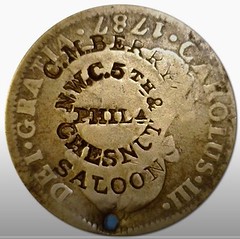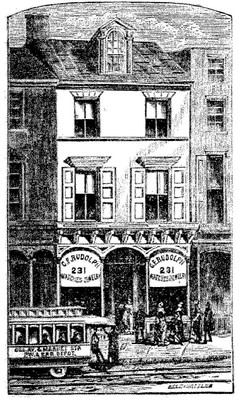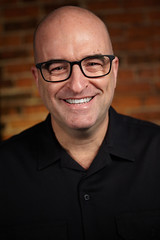
PREV ARTICLE
NEXT ARTICLE
FULL ISSUE
PREV FULL ISSUE
BILL GROOM INTERVIEW, PART FOURGreg Bennick's latest interview for the Newman Numismatic Portal is with counterstamp researcher Bill Groom. Here's the fourth and final part, where Bill discusses his counterstamp database. -Editor
Bill Groom Right. One of the things I did in my database I have for each counterstamp about twenty fields of information. And I am hoping that eventually that'll end up on the Newman Numismatic Portal there. One of the fields I call a proof scale. And in other words, this regards attribution. If I have a 0 in that box, it means there's probably no way this piece is ever going to get attributed. If I have a 1, it means, well, this one could probably be attributed, but there are so many people that this could be. We're just at that level. If it's a 2, I've narrowed it down to maybe two good candidates that could have might have stamped that piece. Now, it's not either or, but it is probably one of these two. And if it's a 3, then I have narrowed it down pretty much by - most of the evidence points to the stamp having been produced by one person, and it may not be correct, but the evidence suggests same. And then a 4 would be this is a slam dunk attribution with absolute proof. I've got a, let's say, an invention with stamped by the same fellow a photograph, a gun, a coin, a silver piece of silverware, whatever - the same mark exists elsewhere. And we can nail it down. Say, this is the guy that's a 4. Greg Bennick What I love about your detective work, about these pieces is that it makes coin collecting, counterstamp collecting an active rather than passive process. Meaning I could certainly go on eBay right now or find an auction house and start buying counterstamps and just fill drawers with them. But I love the active engagement that you have put into this work and the idea that you are not just buying the coin, but then researching the history of it and connecting it to actual history and then trying to authenticate that attribution. Would you say that's the most important aspect of collecting counterstamps, the attribution process? Bill Groom Well, sure, because that's where all the meaning is that's the meaning of the piece, the history behind it. How can you say that the history is valid if you can't prove that this is the guy? I wrote an article on a slave named Louis Temple. I have two of his counterstamps. L Temple. For years I struggled with being able to say that he was the actual person who stamped these coins because I found two L. Temples. But one of the important things is to have a lot of research material at your hands. One of the books - the early directories that I find most helpful because counterstamping was at its peak in the 1850s was a New England directory from 1856 that covers the New England states. Well, there are two Temples listed in the 1856 directory. One of them was a Levi Temple and he was a blacksmith in a little town in Maine, and the other was Louis Temple, and he was also a blacksmith, but he was in New Bedford, Massachusetts. And my suspicion was that Louis was the fellow who stamped those two coins that I was able to acquire over a period of time. I got I think I got them about five years apart. I was always looking for one thing. When I find one specimen of a counter stamp, I always look for a second. I try to keep in mind that this counterstamp, is on more than one coin. You know, it might have been a business connection or it substantiates the attribution, maybe. But anyway, getting back to the Louis Temple, I found out that he was not just a simple blacksmith, but he produced harpoons for the whaling industry and he was a black man. He escaped slavery, got the found his way in to New England in about 1829, married, opened a blacksmith shop. He had blacksmith skills that he learned while he was a slave. Probably Temple came from the plantation he was on. He was from the Temple Plantation. Well, Louis had heard about talking with whalers, about harpoons that had a toggle head, and he started producing them, showing a harpoon when it got into the whale it would snap a little wooden pin and the end of the spear and would flip 90 degrees. And they could reel the whale in that. Well, his harpoon doubled the whaling rate. So for years I was looking for one of those harpoons to see if he stamped it. And sure enough, there are a couple of harpoons that are stamped and I had to get close up pictures of the stamp and I show in my articles, the close up pictures and how they match. If you look at the letters, a couple of the letters are very distinctive and you can see the points that match in the letters. Greg Bennick This is incredible. And for anyone listening, if that story just on its own didn't inspire you to read Bill's articles, I'll tell you personally that before we did this interview that Bill sent me some articles and in some email said, Hey, you know, would you like to read some articles? Well, I flew to England last week and then flew back the other day and while on the plane read a dozen or so of your articles, all of them entertaining all of them engaging all of them with a story behind them. I would highly recommend that listeners seek out Bill's articles and just read them and enjoy these historical stories or analysis of different counter stamps. Its just fascinating. I love the harpoon story. I think that's it's quite incredible and really ties into what we were speaking about before, about connecting history with the coin itself. So what advice would you offer to other counterstamp collectors? Bill Groom Well, I think find as many resources as you can. Authenticate the stamps. I have an online library that I use through Google that I've established. You have that ability to do that online and you can put in links to different directories or early directories. One of the problems is that I found over the years the genealogy websites have cornered the market on these resources because they can make money by giving you access to them. Many years ago when I first got on a computer, I was able to buy some disks with early directories. You can't do that anymore. So get on Google, maybe an open a library, start your own library there with these early directories. There are occupational listings, occupational websites for silversmiths, gunsmiths of all sorts, all cutlers, surgical instrument makers, clock makers, you name it. And there are you can find listings of people. Then what you do if you find a listing, let's say, of a silversmith and you can match a hallmark. There are pictures of the hallmarks on there. So you can build your own library and go to it whenever you see a counterstamp and do your own research. You want to try to find try to focus on stamps that have a name and probably two initials that go with it or a first name or town. This is where I hope the Newman website will offer some of these - possibly build up a library in addition to not just coins, but the focus on resources like early directories and assist collectors in doing making the connections. Greg Bennick I like that a lot. And I was going to ask about how you envision the Newman Numismatic Portal helping to advance the study of counterstamps not just providing an interview like this, but maybe the resources where other or new collectors can go to learn about the counterstamps that they are finding out in the world.
Bill Groom
Right. I was looking online this morning and I've been watching one of the pieces I was
watching online. It's a BR&M counterstamp, and it's in a little curated box with an
ampersand in it. And so it looks very old. Actually, it looks like it's an old silversmith
counter stamp, but it's not. It's from a buddy of mine stamped it in New Jersey a couple of
years ago and the guy has a price tag on it, of $499. And I wrote to him and I told him, I
said, Greg Bennick Bill, this is so important and so amazing. And the thing that I'm taking away from this interview is just the idea of do your own research, but not just do your own research because you might get ripped off, do your own research because history is fascinating. Coins are incredible, counterstamps are really interesting. And there's a sort of focal point amongst all those aspects of counterstamps where people can really learn a lot and enjoy the coins more because they're doing their own historical research. I think that's pretty fascinating.
Greg Bennick See, this is really important. And people, you know, everyone always says that, you know, education is most important for people. And it and it truly is. And I think that there's a wealth of history to learn. And new collectors shouldn't certainly be discouraged about how much there is to learn, but rather take this interview as inspiration for just maybe learning about one aspect of counterstamps. Like I mentioned myself, I own two….I actually own a third, which is a counterstamp from Great Britain. But the point is, is that I own three and two of them are my current area of focus, meaning that I just decided on one counterstamp and learned what I can about that and I'm learning what I can about that, and I'd recommend that people start there. Just pick one industry, one counterstamp, one name, maybe, and start there and learn what you can learn and then start developing your database of information. As you said, I think that's really great advice. Bill Groom Some people collect also by occupation but they might collect by the location too. I know with New York, with Civil War tokens, I was very interested in New York Civil War tokens, but I lived in that state most of my life. Greg Bennick Well, that makes a lot of sense. And I appreciate your time so much today. And you know, you mentioned resources like the National Token Collectors Association and the Civil War Token Society. Are there other places that you might send people, both of those being excellent? I would highly recommend both as well. But are there other places that you'd recommend, other organizations you'd recommend, or would you have people start with those two. Bill Groom I'd say go to local coin clubs, local shows, talk with dealers or dealers who specialize in exonumia. Steve Hayden is one of the top dealers in exonumia in the country. And you can find him if you go online. Also, I would say there are there are some websites. So one of my favorites is a COIN Community Forum or CCF and my name on there is ExoGuy and somebody could contact me there. I go on there. I've made a couple of thousand postings on there and many of them are about counterstamps. That's a good site to go to . Another one is Coin Talk. That's a good website. So I would highly recommend both of those. And you'll find other people, you know, that collect counterstamps. And I actually I maintain there are three guys that that I contact fairly regularly it's Florida Bob and my buddy Bruce from New Jersey and Guy Michael in Massachusetts and these guys are all top collectors and they have hundreds of specimens of counterstamps in their collections and the reason I just mention those is networking helps because we learn from one another. Greg Bennick That's fantastic advice and it's certainly been true today. I know that even as we've been speaking, I'm sitting here with Russ Rulao and Gregory Brunk's books in front of me and I'm going to dive into them with new energy after our conversation. I'm very excited that we had a chance to talk today, and I'm very thankful for your time. I'll certainly be posting this interview along with links that people can reference below the interview so that people can start their own process of learning about counterstamps. Bill Groom Great. And I'm hoping to work with the Newman Numismatic Portal, and I'd love to see something going on there, something that's going to be not just static, but dynamic where it can be built upon data. In other words, with my database on that, it could be expanded and other people would contribute to it. There wouldn't be Bill Groom's database. It would be the, the collector's database. Greg Bennick That's great. I love that. I love that community spirit. Well, Bill, thank you so much for your time today. I really love that community spirit and the idea that we can all come together and learn from one another. And I look forward to the Newman Numismatic Portal's posting of this interview and also the development of counterstamps as a field for collectors and to have that grow. I'm really excited about that. Thanks so much for your time. Bill Groom Thank you very much, Greg.
To watch the complete video, see:
To read the complete transcript, see:
To read the earlier E-Sylum article, see:
Wayne Homren, Editor The Numismatic Bibliomania Society is a non-profit organization promoting numismatic literature. See our web site at coinbooks.org. To submit items for publication in The E-Sylum, write to the Editor at this address: whomren@gmail.com To subscribe go to: https://my.binhost.com/lists/listinfo/esylum All Rights Reserved. NBS Home Page Contact the NBS webmaster 
|









